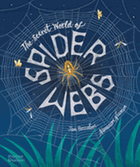
Thirteen different kinds of webs and the spiders that build them take center stage in The Secret World of Spiderwebs, a fact-filled guide by debut children's author Jan Beccaloni, senior curator of Arachnida and Myriapoda at London's Natural History Museum.
"Fossils from 50 million years ago tell us that spiders" have been building webs since birds were evolving from dinosaurs. Spiders do this by creating a liquid protein inside their abdomen which, when pulled from their body and exposed to air, hardens into a thread. "Many people think that a spider's web is its home.... but a web is also a highly technical device for catching prey." Each double-page spread explores a web structure--such as the lace web of the twig spider or the sheet web of the hammock spider--and includes descriptive text about the spider's natural habitat as well as descriptions of how the webs work. Details, like how some spiders use webs as a fishing line (water web) while others work as a family unit (colony web), will likely capture readers' curiosity.
Illustrations by Namasri Niumim (Bird Spotter) depict attractive, active, and, in the case of the large-eyed ogre-faced spider, sometimes silly arachnids and their habitats. Occasional awkward phrasing makes a slightly clunky reading experience and readers sympathetic to a spider's prey may want to seek another source. But Beccaloni expertly conveys interesting facts and includes a spider-spotter's guide, a glossary, and a list of sources. The Secret World of Spiderwebs will surely entrap readers who love to learn about arachnids and may act as a wonderful resource for teachers and librarians. --Nicole Brinkley, bookseller and writer

